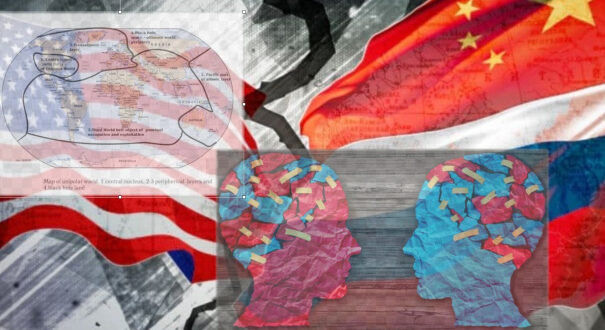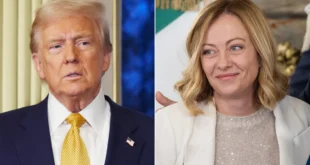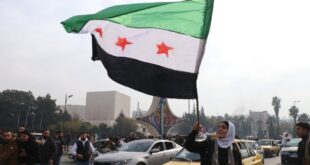In the modern world, a multipolar model is clearly taking shape – almost taking shape. It replaced the unipolarity that was marked after the collapse of the Warsaw Pact and especially the USSR. And the unipolar world, in turn, replaced the bipolar one, in which the Soviet camp geopolitically and ideologically opposed the capitalist West. These transitions between different types of world order did not take place overnight. Some aspects changed, but some remained the same by inertia.
Depending on the change in the entire planetary picture, the ideological nature of all global players or poles was formed.
A closer analysis of such ideological transformations – past, present, and future – is essential for strategic planning.
And although the Russian government has developed a regrettable tradition of solving problems only as they arise and prioritizing only answers to immediate challenges (as they say today “to act at the moment”), no one is free from global ideological shifts. Just as ignorance of the law does not exempt from responsibility, the refusal to comprehend the worldview foundations of the world order and their changes in no way relieves the authorities – Russia as a whole – from the deep laws inherent in the sphere of ideology. Any attempt to replace ideology with pure pragmatism can have an effect – and even then only relative and always reversible – only in the short term.
In a bipolar world, respectively, there were two global ideologies –
- liberalism (bourgeois democracy) defined the idea of the capitalist camp, the global West,
- communism was the Idea of an alternative socialist East.
There was an inextricable link between the geopolitical poles – East-West and the corresponding military-strategic zoning of the world (land, water, air, and finally, outer space) and ideologies. This connection influenced everything – including technical inventions, economics, culture, education, science, etc. Ideology captured not only consciousness but also things themselves. It has long passed from the level of polemics about global problems to the competition of things, products, tastes, etc. But ideology nevertheless predetermined everything – down to the smallest detail.
Looking ahead, it should be noted that China in the conditions of a bipolar world was not an independent pole. Initially, Maoism was part of the Eastern camp. And after Stalin’s death, a cooling began between the USSR, along with the satellites and China, but strictly within the framework of the communist bloc. Finally, China began to follow an independent geopolitical line only with Deng Xiaoping, when Beijing entered the era of reforms, and processes of large-scale degradation began in the USSR. But the world – all the more decisive! – China did not play a role then.
It is important to note that this was the case not only in the USSR and the socialist countries. It was exactly the same in the West. And their liberalism represented precisely the dominant ideology. At the same time, the flexible bourgeois approach sought not only to suppress and exclude its opposite but to transform it. So along with the marginal, primarily communist and pro-Soviet parties, there were “tame” leftists – social democrats who accepted the basic postulates of capitalism but hoped to correct them in the future through gradual reforms in a socialist key. In Europe, the left was stronger. In the USA – the stronghold of the West – they were under the harsh ideological and administrative pressure of the authorities. For ideological reasons.
When the Warsaw Pact was dissolved and the USSR collapsed, a unipolar model took shape. At the geopolitical level, it corresponded to the sole domination of the West, its achievement of undeniable superiority and total leadership overall potential opponents (primarily over the remains of the Eastern Bloc represented by Russia in the 90s of the 20th century). This is reflected in the most important strategic documents of the United States of the 1990s – the military doctrine of “full-spectrum dominance” and the prevention of the emergence in Eurasia of a geopolitical entity capable of somehow limiting the completeness of US planetary control. This was called the “unipolar moment” (C. Krauthammer).
Ideological domination corresponded to geopolitical unipolarity.
Back in the 1930s, the Italian communist Antonio Gramsci proposed using the term “hegemony” primarily as a worldwide expansion of capitalist ideology. After the fall of the USSR, it became obvious that the military, economic and technological hegemony of the West was accompanied by another form of hegemony – ideological – that is, the total spread of liberalism. This is how one ideology began to prevail almost all over the world – the liberal one. It was built on the basic principles that hegemony considered and imposed as universal norms:
- individualism, social atomization,
- market economy,
- unification of the world financial system,
- parliamentary democracy, multi-party system,
- civil society,
- technological development and, above all, “digitalization”,
- globalization,
- the transfer of more and more powers from national states to supranational authorities – such as the International Monetary Fund, the World Bank, the World Health Organization, the European Union, the European Court of Human Rights, the Hague Tribunal.
In the unipolar world, this ideology has become not only Western but the only one. China has accepted it in terms of economy and globalization. Russia of the Yeltsin era – as a whole.
And again, as in the bipolar world, the field of ideology was not limited to the highest spheres of politics, it pervaded everything – education, culture, technology. The very objects and technical devices of the unipolar world were a kind of “proof” of the ideological triumph of liberalism. The very concepts of “modernization” and “progress” have become synonymous with “liberalization” and “democratization”. And accordingly, the West, while strengthening its ideological power, strengthened direct political and military-strategic control.
Yeltsin’s Russia was a classic illustration of this unipolarity: helplessness in international politics, blindly following Western curators in the economy, desovereignization, an attempt by the comprador elites to integrate into global capitalism at any cost. The Russian Federation was created on the ruins of the USSR as part of a unipolar world, swearing allegiance to the basic principles of liberalism in the 1993 Constitution. In conditions of unipolarity, liberalism has advanced even further in its individualism and technocracy. A new stage began when gender politics, the critical race theory came to the fore, as well as the horizon of the near future – the transition through deep ecology to posthumanism, the era of robots, cyborgs, mutants, and Artificial Intelligence. American embassies or NATO military bases around the world have become the ideological representations of the global LGBT movement. LGBT people are nothing more than a new edition of advanced liberalism.
But the “end of history”, that is, the triumph of global liberalism, which the globalists (for example, Fukuyama) hoped for, did not happen.
The hegemony began to falter. In Russia, Putin came to power, who with an iron hand took a course towards restoring sovereignty, ignoring the ideological aggression of external and internal agents of hegemony (in principle, both parts of a single whole – the general structure of world liberalism). China has broken out into the world leaders, while maintaining the sole power of the Communist Party and carefully guarding Chinese society against the most destructive aspects of globalism – hyper-individualism, gender politics, etc.
So the next one began to emerge – a multipolar model of the world order.
And here the question of ideology is extremely acute. Today, due to the inertia of the unipolar world (which in turn inherits the ideology of one of the poles of the bipolar capitalist West), world liberalism in one form or another retains the function of operating systems of thinking. So far, none of the emerging full-fledged poles – that is, neither China nor Russia – have challenged liberalism as a whole. Yes, China rejects parliamentary democracy, Western interpretations of human rights, gender politics, and cultural individualism.
Russia, on the other hand, strongly insists, first of all, on geopolitical sovereignty, puts national law over international law, and increasingly begins to incline towards (as yet vague and not articulated) conservatism. At the same time, both Russia and China (especially when acting together) are able in practice to ensure their sovereignty at the strategic and geopolitical level. The matter is small: to finally move to full-fledged ideological multipolarity and oppose the liberal Idea – the Russian Idea and the Chinese Idea.
It should be noted that in the ideological confrontation with the West, some Islamic countries and movements have gone much further – primarily Iran, as well as Pakistan, and even some radical organizations like the Taliban (banned in Russia). Turkey, Egypt, and even partly the Gulf countries are moving in the direction of sovereignty. But so far no country in the Islamic world is a full-fledged pole. That is, in their case, the ideological opposition to hegemony is ahead of the geopolitical one. The Chinese Idea is not difficult to capture. It is expressed
firstly, in the Chinese version of communism and in the complete monopoly of the CCP on power (and the CCP is precisely an ideological force),
secondly, in the Confucian ideology, which the Chinese authorities are more and more openly taking on the shield (especially under Xi Jiangping),
thirdly, it is the deep and organic solidarity of the Chinese society.
A very strong and at the same time flexible Chinese identity that turns any Chinese, wherever he lives, and a citizen of whatever country he is, into a natural bearer of the Chinese tradition, civilization, and its structures.
Things are much worse in Russia. By inertia in the 90s, liberal attitudes, values , and guidelines continue to prevail in society. This applies to the capitalist economy, parliamentary democracy, the structure of education, information, and culture. The aim is modernization and “digitalization”. Almost all assessments of efficiency, effectiveness, as well as the very goals of any transformations, are directly copied from the West. There are some differences only in the issue of restricting gender politics and ultra-individualism. The liberal West itself deliberately exaggerates and inflates them. But in order to attack Russia more and more. This is an ideological war. In the case of Russia, this is the struggle of liberalism against “non-liberalism”.
In Russia, everything rests on Putin personally. Loosen his grip, or, God forbid, appoint a weak and indistinct figure as his successor – everything will instantly slide into the 90s. Russia got out of them thanks to Putin, but due to the lack of an independent Russian ideology, full-fledged counter-hegemony, this outcome cannot be considered irreversible.
The RF today is a military-strategic and political pole, but ideologically it is not such a pole.
And this is where the problems begin. An inertial return to Soviet ideology is not possible. Although social justice and imperial greatness (especially in the era of Stalin) are not just Soviet, but historically Russian values and guidelines.
Russia needs a new form of anti-liberalism, needs a full-fledged civilizational ideology, which will make it irreversibly and finally a true pole and subject in the new world order. This is the number one task for Russia. Strategy, and not just tactics, determine the future, and the transfer of power, and the necessary long-overdue reforms of power, administrative management, economy, education, culture, and the social sphere. Without a full-fledged ideology in the conditions of multipolarity, no – patriotic, sovereign – reforms can be carried out. But this path is incompatible with liberalism in nothing – not in the premises, not in the latest post-humanist and LGBT challenges.
For Russia to exist, there should no longer be liberalism in Russia.
It is here that lies the key to what we talked about in previous publications in Nezygar – to the transition to the third pole of the Russian – ideological! – the future: from the pro-Western liberalism of the 90s (past) through compromises and ideological sterility (on the verge of cynicism) of the present. We will continue this topic in the next articles of this series.
 Geostrategic Media Political Commentary, Analysis, Security, Defense
Geostrategic Media Political Commentary, Analysis, Security, Defense





